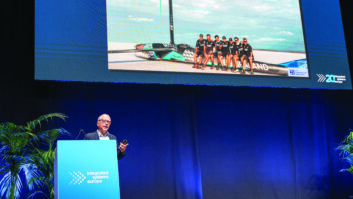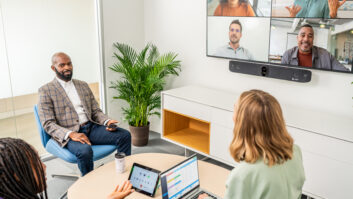What is your strategy for developing Poly going forward: any plans you’d like to discuss?
Poly customers need the tools and technology that will allow their employees to work from anywhere – with a consistent, enterprise-grade experience — and employees want the same experience in their home office as in their campus-based office.
 At the same time, IT managers need tools that are easy to deploy and manage, and give intelligent insights and analytics so they can more proactively manage their business.
At the same time, IT managers need tools that are easy to deploy and manage, and give intelligent insights and analytics so they can more proactively manage their business.
We at Poly are focused on developing and delivering a comprehensive portfolio that spans the home like our EagleEye Mini HD video-conferencing camera, through to the largest of office conference rooms, with our G7500 video-conferencing system.
Our strategy is to ensure we are giving all users amazing sound and voice in any situation through our industry-leading headsets, desk and conference phones, and our newly-announced intelligent speaker phones, the Sync family.
How do you see Covid-19 changing the way Poly approaches its business model, and are there opportunities as a result of the new normal?
While Covid-19 has brought its share of challenges for many companies, it has opened a whole new way of doing business for most. Many companies have used this time to digitally transform their businesses, look at ways to work that deliver upon productivity goals while giving employees more time with their family.
The pandemic has given employers time to shape and design their organisations in a way that supports the needs of the business while protecting employees. This requires them to use technology in news ways as we move away from traditional office-based tools to technologies that enable hybrid ways of working.
Poly offers exciting technology now that improves the user experience and is more inclusive of employees working from home. When people can work from anywhere, we can all access a more diverse talent pool, which brings new opportunities.
Because Poly is in the video, audio and collaborative business, we have been lucky in that our employees didn’t miss a beat in 2020. We saw great results during this time, both because of increased demand in our video and voice solutions and also because our employees were well-equipped to operate in this new environment.
What technological innovations do you expect to dominate over the next few months and years, and how much of an affect with the pandemic have on the types of tech deployed?
Hybrid working is here to stay. Employees are going to work from wherever they deem is the most appropriate for the task at hand, where individual work may be done at a home workstation and group work from a redesigned office. Thanks to the cloud – everyone will be able to be productive from wherever they are.
Multiple tools may be needed to fully enable hybrid working, as there is no one-size-fits-all tool that works in all locations and situations. For example, more people will begin to use more than one headset, such as a different one at their desk than they use while traveling.
Offices will be completely transformed for the future, using smaller footprints, and with a new mission – one that is primarily for group work, such as meetings, brainstorming, celebrating, instead of individual work. The past accepted ratio of 30% meeting rooms to 70% workstations at offices will probably completely flip.
We will see a “remote first” mentality in how we work. Office meetings rooms will be equipped with modern, AI-driven collaboration technology to better connect to the much larger percentage of remote workers and create an inclusive experience.
Multi-purpose platforms give enterprise technology managers flexibility in the hybrid environment. These IT managers need room endpoints that support multiple collaboration applications or have an interoperability scheme for other platforms that may work today but may not tomorrow. This will make endpoints and devices that can natively connect to different collaboration services much more valuable to the enterprise going forward.







